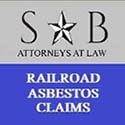
The Hidden Dangers of Asbestos Exposure
Asbestos, once hailed for its durability and heat-resistant properties, has since been revealed as a silent killer, responsible for a variety of serious health conditions, including cancers. Exposure to asbestos fibers can lead to the development of mesothelioma, lung cancer, and other forms of asbestos-related cancers. These conditions often manifest decades after initial exposure, making early detection and legal compensation critical for affected individuals.
Understanding Asbestos-Related Cancer
Asbestos-related cancer is primarily caused by inhaling or ingesting asbestos fibers, which then lodge in the body’s tissues. Over time, these fibers can cause inflammation, scarring, and eventually, cellular changes that lead to cancer. The most common types of asbestos-related cancers include:
- Mesothelioma: A rare and aggressive cancer that affects the lining of the lungs, abdomen, or heart. It is almost exclusively linked to asbestos exposure.
- Lung Cancer: While smoking is the primary cause, asbestos exposure significantly increases the risk, especially in smokers.
- Throat and Esophageal Cancer: These cancers can develop in the throat or esophagus after prolonged asbestos exposure.
- Stomach and Colon Cancer: Asbestos fibers can also contribute to gastrointestinal cancers, often due to swallowing fibers after inhalation.
The Legal Landscape for Asbestos Claims
For individuals diagnosed with asbestos-related cancer, multiple legal avenues exist to seek compensation, reflecting the gravity and widespread impact of asbestos exposure. Over the past several decades, the legal system has responded to the asbestos crisis by establishing numerous asbestos trust funds. These funds were created as part of bankruptcy proceedings for companies that used asbestos products extensively. The goal is to ensure that victims of asbestos exposure receive fair compensation, even if the responsible companies are no longer in business.
Asbestos trust funds collectively hold more than $30 billion, specifically earmarked for individuals suffering from asbestos-related diseases. These funds are designed to provide financial relief without requiring victims to endure lengthy litigation or court appearances. The process of claiming from these trusts is structured to be as streamlined as possible, focusing on the severity of the illness, the level of exposure, and the claimant’s work history.
In addition to trust fund claims, individuals may also pursue personal injury or wrongful death lawsuits against asbestos manufacturers and distributors. These legal options can be pursued if the responsible companies are still in operation or if the trust fund compensation is insufficient to cover the victim’s needs. Lawsuits may also target companies that supplied or installed asbestos-containing products.
Navigating the legal landscape for asbestos claims requires specialized knowledge due to the complex nature of asbestos-related cases and the various legal mechanisms involved. Legal representation by experienced attorneys, such as those at Sammons and Berry, P.C., ensures that victims and their families receive the maximum compensation possible. The firm’s expertise is crucial in identifying all potential sources of compensation, whether through asbestos trust funds, lawsuits, or settlements.
Railroad Workers and Asbestos Exposure
Railroad workers represent a significant group of individuals heavily impacted by asbestos exposure. The railroad industry, from the 1930s to the late 1970s, extensively utilized asbestos in various applications due to its heat-resistant and insulating properties. Asbestos was commonly found in brake pads, insulation materials, gaskets, and other components of railroad machinery and infrastructure. Workers who were involved in the maintenance, repair, or construction of trains, tracks, and related equipment were routinely exposed to asbestos dust and fibers, often without proper protective measures.
The nature of railroad work often involved high levels of asbestos exposure, particularly in enclosed spaces such as engine rooms, brake compartments, and workshops where asbestos-containing materials were cut, drilled, or otherwise disturbed. The workers in these environments were at high risk of inhaling asbestos fibers, which could lodge in their lungs and other tissues, leading to serious health consequences many years later.
The long latency period associated with asbestos-related diseases means that many former railroad workers are only now being diagnosed with conditions such as mesothelioma, lung cancer, and asbestosis. This delay between exposure and the onset of disease poses unique challenges in proving the link between their work and their illness. However, the historical use of asbestos in the railroad industry is well-documented, and numerous studies have established the connection between occupational asbestos exposure and the development of these diseases.
For railroad workers diagnosed with asbestos-related conditions, pursuing compensation through asbestos trust funds is not only possible but often necessary to cover the significant medical costs associated with their treatment. The clear historical evidence linking railroad work to asbestos exposure strengthens their claims, making them strong candidates for compensation from the billions of dollars set aside in trust funds. Additionally, if the responsible companies are still in business, these workers may also have the option to file lawsuits to seek additional compensation.
The Role of Secondary and Household Asbestos Exposure
While the primary focus of asbestos-related claims is often on the workers directly exposed to asbestos on the job, it is crucial to recognize the significant impact of secondary and household asbestos exposure. This form of exposure occurs when asbestos fibers are inadvertently brought home on a worker’s clothing, hair, or personal items, exposing family members to the same dangerous fibers. Secondary asbestos exposure has been a particularly insidious problem, as it often went unrecognized for many years, leaving spouses and children of workers vulnerable to the same deadly diseases associated with direct occupational exposure.
Household asbestos exposure is particularly dangerous because it typically occurs in environments where asbestos fibers can easily become airborne, such as during the handling and laundering of contaminated clothing. Spouses, often responsible for washing their partner’s work clothes, were exposed to asbestos fibers that were released into the air during the shaking out and washing of these garments. This exposure could be compounded by the small, enclosed nature of home laundry rooms, where ventilation was often inadequate, leading to higher concentrations of airborne asbestos fibers.
The latency period for asbestos-related diseases, which can extend up to 30 years or more, means that family members exposed to asbestos in this way may only begin to show symptoms long after the initial exposure. This delayed onset makes it challenging to connect the illness to asbestos exposure, particularly in cases where the affected individual did not work directly with asbestos themselves.
However, the legal system recognizes the validity of claims related to secondary asbestos exposure. Family members who have developed asbestos-related diseases as a result of exposure to asbestos brought home by a worker may be eligible to file claims with asbestos trust funds or pursue lawsuits against the companies responsible for the original exposure. These claims can provide much-needed financial compensation to cover medical expenses, lost wages, and other related costs.
Sammons and Berry, P.C., has extensive experience in handling cases of secondary asbestos exposure. The firm is well-equipped to navigate the complexities of these claims, ensuring that family members affected by secondary exposure receive the compensation they deserve. Their expertise includes gathering the necessary evidence to establish the link between the worker’s occupational exposure and the subsequent household exposure that led to the family member’s illness.
Filing a Claim: The Process and What to Expect
Filing an asbestos claim can be a daunting process, but it is essential for securing compensation to cover medical bills, lost wages, and other expenses. Here’s a simplified overview of the process:
- Initial Consultation: The first step involves contacting a specialized asbestos attorney, such as the team at Sammons and Berry, P.C., for a free consultation. During this consultation, the attorney will gather information about your work history, medical diagnosis, and potential sources of asbestos exposure.
- Case Evaluation: The attorney will evaluate your case to determine eligibility for compensation. This may involve reviewing medical records, employment history, and other relevant documents.
- Trust Fund Identification: There are multiple asbestos trust funds, each with its criteria. Your attorney will identify which trusts you are eligible to file claims with, based on your specific circumstances.
- Claim Filing: Once the appropriate trusts are identified, your attorney will prepare and file the necessary claims on your behalf. This process often requires detailed documentation, which the attorney will manage to minimize the burden on you.
- Compensation Recovery: After filing the claims, it may take some time for the trust funds to process and approve them. However, once approved, you will receive compensation without the need for a lawsuit or court appearance.
- No Upfront Costs: Importantly, law firms like Sammons and Berry, P.C., work on a contingency basis. This means you do not pay any legal fees unless compensation is recovered on your behalf.
The Importance of Early Action
Due to the latency period of asbestos-related diseases, individuals exposed to asbestos may not show symptoms for decades. However, early legal action is critical. Statutes of limitations vary by state, meaning there is a limited window in which you can file a claim. Even if you are currently symptom-free but know you were exposed to asbestos, it is advisable to consult with an attorney to explore your options.
Support for Families of Asbestos Victims
Asbestos-related diseases often result in significant financial and emotional strain on families. Beyond medical expenses, the loss of income and the emotional toll of caring for a sick loved one can be overwhelming. Fortunately, asbestos trust funds are designed to provide support not only to the affected individual but also to their families.
Spouses and other family members who have suffered from secondary asbestos exposure may also be eligible for compensation. This is particularly relevant for those who have developed symptoms related to asbestos exposure through laundering contaminated clothing or other forms of indirect contact.
Why Choose Sammons and Berry, P.C.?
When dealing with something as serious as asbestos-related cancer, having the right legal team is crucial. Sammons and Berry, P.C., has decades of experience specifically in handling asbestos claims for railroad workers and their families. They understand the unique challenges faced by these individuals and have a proven track record of securing significant compensation.
- Specialization in Railroad Asbestos Claims: The firm specializes in helping railroad workers navigate the complexities of asbestos claims, ensuring they receive the compensation they deserve.
- Comprehensive Legal Support: From the initial consultation to the final payout, Sammons and Berry, P.C., handle every aspect of the claim process, minimizing stress and maximizing your compensation.
- No Win, No Fee: With no upfront costs and a contingency fee structure, you can pursue your claim with confidence, knowing you won’t be out of pocket unless your claim is successful.
Taking the Next Step
If you or a loved one has been diagnosed with an asbestos-related disease, it’s crucial to act quickly to secure the compensation you deserve. The attorneys at Sammons and Berry, P.C., are ready to assist you every step of the way, ensuring that you receive the financial support needed to cover medical expenses, lost wages, and other associated costs.
Don’t wait until it’s too late—reach out today for a free consultation and take the first step towards securing your future.
See if you qualify for compensation
Sammons & Berry, P.C.
800-519-1440
View our Google Listing
View our Facebook


